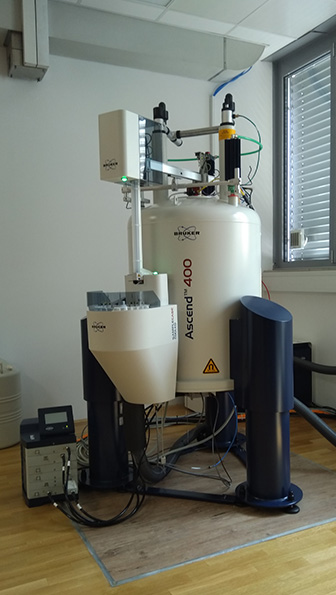400 MHz Nuclear Magnetic Resonance Spectrometer (Nika)
Slovenian NMR Centre in Ljubljana
Nuclear Magnetic Resonance spectroscopy is a research technique that exploits atomic nuclei with non-zero magnetic moments to act as tiny probes for the detection of the local structure, dynamics, reaction state and chemical environment within molecules. NMR spectra are unique, well-resolved, analytically tractable and often highly predictable for small molecules. NMR analysis is therefore used for confirming the identity of a substance. Different functional groups are easily distinguishable and identical functional groups with differing neighbors still give distinguishable signals. NMR is also a valuable tool for studying local structure and dynamics in a variety of solid systems. Objects of such solid-state NMR studies in materials science are inorganic/organic aggregates in crystalline and amorphous states, composite materials, heterogeneous systems including liquid or gas components, suspensions and molecular aggregates with dimensions on the nanoscale.

Contact: Janez Plavec
Tel:+386 147 60 353
Technical specifications Agilent Technologies DD2 600 MHz
MAGNET
9.39 T 54 mm bore ASCEND superconducting magnet
CONSOLE
Four channel AVANCE NEO console (two high band 1H and 19F channels and two broad band channels, 6-365 MHz)
High power amplifiers and preamplifiers on high band (1H-19F) and broad band channels (31P-15N) for solid state measurements
System for automatic matching and tuning on all channels
10 A gradient module
Advanced Bruker Smart Variable Temperature (BSVT) control unit
PROBES
5 mm BB(F)O Iprobe with z-gradient (5 gauss/cm*A), inner coil optimized for observation of nuclei between 31P and 107Ag, outer coil optimized for 1H decoupling (and observation), automated tuning and matching provided with Bruker ATM (VT range: -150 °C to +150°C)
4 mm CP-MAS probe with 1H-19F and 31P-15N coils, maximum spinning rate 16 kHz, automated tuning and matching provided with Bruker ATM, VT range -150 °C to +150 °C.
10 mm Bruker DUL probe, with inner coil optimized for 2H detection and outer coil for 1H decoupling, with a 19F lock, automated tuning and matching with Bruker ATM (VT range -130 °C to +150 °C)
5 mm BBI probe inner coil optimized for 1H detection, outer coil optimized for decoupling of nuclei between 31P and 15N, automated tuning and matching provided with Bruker ATM, VT range -150 to 150 °C.
SAMPLECASE
A 24 sample, random-access, automation system (temperature range: 0 °C to 40°C)
HOST COMPUTER
HP Z4 G4 Workstation, Intel Xeon W-2135 CPU, 32 GB ram, Samsung Evo850 250GB SSD + Toshiba 2TB hard drive, Quadro P2000 graphic card, HP z24nG2 24″ LCD monitor
SYSTEM
Windows 10
SOFTWARE
Bruker Topspin 4.0.9
Detailed information can be found on the Instrument’s webpage.
-
20.02.2025
X-ray computed tomography (CT) TomoLab
-
23.01.2025
THz beamline TeraFERMI



